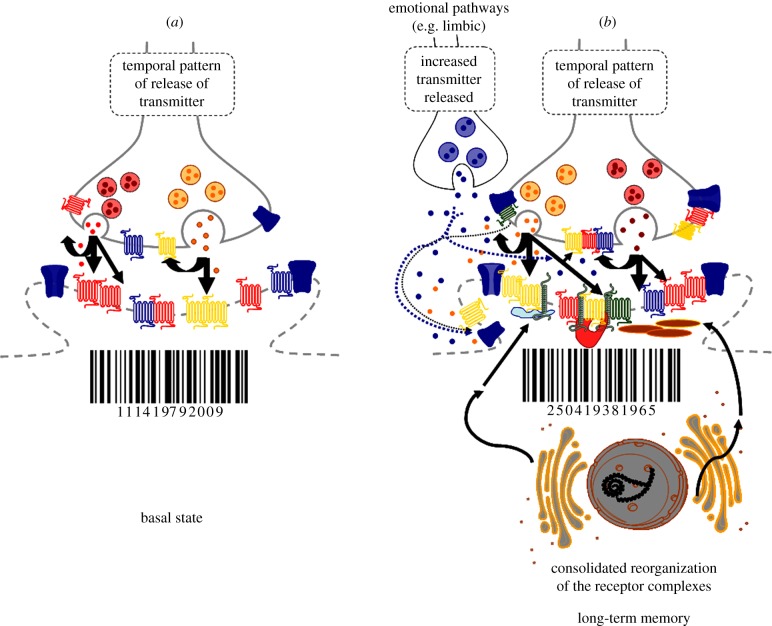Figure 4.
Illustration of a novel theory on the molecular basis of learning and memory based on the reorganization of homo- and heteroreceptor complexes in the postjunctional membrane of synapses (synaptic and extrasynaptic components) leading also to changes in the prejunctional (synaptic and extrasynaptic components) homo- and heteroreceptor complexes to facilitate the pattern of transmitter release to be learned. Learning is regarded to occur through changes in the synaptic efficacies via changes in synaptic strength. A molecular basis for learning and memory may develop through reorganization of the available homo- and heteroreceptor complexes structurally and/or by resetting the multiple allosteric receptor–receptor interactions in these complexes, as well as by the formation of novel heteroreceptor complexes via alterations in the pattern of synaptic and VT signals. Such multiple molecular changes in the heteromers and their receptor–receptor interactions may be the molecular basis for short-term memory, involving multiple changes in the receptor–protein architecture of the heteroreceptor complexes of the postsynaptic membrane as illustrated by the change of bar code. (a) The basal state with its postjunctional receptor complexes leading to a defined bar code. Two types of transmitters are indicated to be released from different pools of synaptic vesicles shown in red and orange. Short-term memory involves transient learning of a new temporal pattern of release of the two transmitters. This pattern is learned by the transient reorganization of the homo/heteroreceptor complexes into inter alia higher order heteroreceptor complexes with novel signalling features. This receptor reorganization leads to a novel bar code which can represent a short-term memory of the new pattern of transmitter release to be learned. (b) The consolidated reorganization of the postjunctional receptor complexes leading to long-term memory is illustrated. The consolidated memory should result in a bar code similar to one found in short-term memory. The mechanism for this process may involve the transformation of parts of the heteroreceptor complexes into unique transcription factors which can lead to the formation of novel adapter proteins some of which can link the heteroreceptor complexes more strongly together. Others can link the heteroreceptor complexes more strongly to the cytoskeleton. In this way, a stable bar code can be obtained. This is illustrated by the arrows from the rough endoplasmic reticulum onto the newly formed adapter proteins, which have become linked to different types of receptor complexes in the postjunctional membrane. GPCR heteroreceptor complexes with ion channels and receptor activity-modifying proteins are illustrated. The impact of VT signals including monoamines from terminals of emotional circuits is also outlined in (b) (dotted arrows). They are postulated to act especially on postjunctional receptor protomers with a significant ability to contribute to transcriptional activation, which leads to production of adapter proteins with a unique efficacy to consolidate long-term memory traces. (Online version in colour.)

